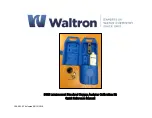
4
PW3335A985-01
Data Formats
The instrument uses character data, decimal numeric data and character string data depending on the command.
(1) Character Data
Character data always begins with an alphabetic character, and subsequent characters may be either
alphabetic or numeric. Character data is not case-sensitive, although response messages from the instrument
are only upper case. When the command data portion contains
<1/0/ON/OFF>
, the operation will be the same
as when 0 is OFF and 1 is ON.
:HEADER OFF
(2) Decimal Numeric Data
Three formats are used for numeric data: NR1, NR2 and NR3. Numeric values may be signed or unsigned.
Unsigned numeric values are handled as positive values. Values exceeding the precision handled by the
instrument are rounded to the nearest valid digit or truncated.
• NR1
Integer data (e.g.: +12, -23, 34)
• NR2
Fixed-point data (e.g.: +1.23, -23.45, 3.456)
• NR3
Floating-point exponential representation data (e.g.: +1.0E-2, -2.3E+4)
The term “NRf format” includes all three of the above numeric decimal formats.
The instrument accepts NRf format data. The format of response data is specified for each command, and the
data is sent in that format.
:AVERAGING 10
The instrument does not completely support IEEE 488.2. Use referenced data whenever possible.
Also be careful not to overflow the input buffer or output queue with a single command.
Compound Command Header Omission
When several commands having a common header are combined to form a compound command (for
example,
:VOLTage:AUTO
and
:VOLTage:RANGe
), if they are written together in sequence, the common portion
(here,
:VOLTage:
) can be omitted after its initial occurrence.
This common portion is called the “current path” (analogous to the path concept in computer file storage), and until
it is cleared, the interpretation of subsequent commands presumes that they share the same common portion.
This usage of the current path is shown in the following example:
Full expression
:VOLTage:AUTO OFF;:VOLTage:RANGe 300
Compacted expression
:VOLTage:AUTO OFF;RANGe 300
The current path allows you to abbreviate the next command.
The current path is cleare
d when the power is turned on, when reset by key input, by a colon “:” at the start of
a command, and when a message terminator is detected.
Standard command messages can be executed regardless of the current path. They have no effect upon the
current path.
A colon “:” is not required at the start of the header of a Simple or Compound command. However, to avoid
confusion with abbreviated forms and operating mistakes, we recommend always placing a colon at the start of
a header.
www.
.com
1.800.561.8187







































